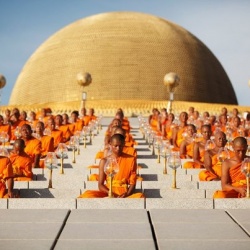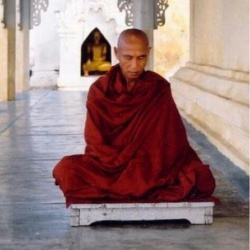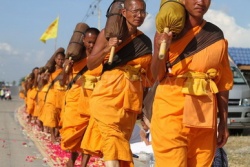Manual of Vinaya - Reading Three: Introduction to the Vows of Individual Freedom
The following selection consists of the first part of Daymaker (Nyin-byed), composed by Master Ngulchu Dharma Bhadra (1772-1851) as a commentary to the Essence of the Ocean of Discipline (‘Dul-ba rgya-mtso’i snying-po), a summary of the vinaya teachings by Je Tsongkapa (1357-1419).
Herein contained is
Daymaker: The Illumination of Lobsang’s True Intent
a commentary upon the
Essence of the Ocean of Discipline.
Lord of the Able Ones, Gentle Voice, Goddess of Song!
The major and minor marks of Your exalted body
which blaze with glorious splendor
Are as majestic as the lord of earth-holders
in the center of his golden chains.
The sixty wonderful qualities
possessed by Your exalted speech
Are as sweet as the many-stringed lutes
of the celestial musicians’ daughters.
Your exalted mind perceives all things
as apparent as the daymaker
On the surface of a cloudless stretch
in the vault of the expanse of sky.
You, who are the indisputable master
of each of the three mysteries—
Those ornaments of infinite circles—
please grant auspiciousness here!
With deep respect I bow down to Lobsang,
child of the goddess of space,
The sun who rose from Tsongka,
over the tip of the eastern horizon.
Like an orb of fire with a thousand tongues of flame,
he makes the mighty Victor’s children—
Those crowning jewels who appeared in Tibet—
look just like ordinary beings.
By churning the great ocean
of the four groups of the Word
That savior procured its very essence:
this unprecedented classic on discipline.
If you take this king of the lord of jewels
and place it atop the victory banner
Of this commentary on its meaning,
Of your and my ultimate happiness
to fall down upon this world.
If you’re like a vessel that’s unpolluted
by the stench of partiality,
And have the intelligence to distinguish
between what’s good and bad,
If you’ve a mind at all like this,
that is like an unconstricted space,
Come and take the deathless nectar
here in these well-spoken words!
I. THE PRELIMINARIES
Now the revered King of the Dharma, the great Tsongkapa of the East, the one known as the glorious Lobsang Drakpa, renowned throughout the three lands, once composed a summary of the vows of individual freedom. This is the text entitled the Shorter Essence of the Ocean of Discipline. My explanation of this work has three divisions: the preliminaries, the actual explanation, and the conclusion. The preliminaries themselves have three parts: the benediction, the eulogy and prostration, and the pledge to compose the work.
THE BENEDICTION
The benediction is expressed in the first line of the text:
Om! May there be happiness and goodness.
The meaning of this line is as follows. The syllable om symbolizes the three mysteries—the exalted body, speech, and mind of the victorious Buddhas. As we intone this syllable, we bear in mind the beings that it represents. These are the victorious Buddhas—possessors of the three mysteries—along with their sons and daughters. And it is to them that we are making our supplication: May all living beings enter the path that leads to the transitory happiness of humans and pleasure beings, or to the ultimate goodness of freedom and omniscience. Then may they reach the state where they possess these three mysteries, exactly as the victorious Buddhas do.
THE EULOGY AND PROSTRATION
The eulogy and prostration are expressed in the next line of the text:
I bow down to the Omniscient One.
Our Lord Lama, at the outset of his treatise, makes a prostration for the benefit of his disciples. He does so for a number of reasons: to help his disciples understand the greatness of the Buddha, to increase his own accumulation of merit, to emulate the holy ones, and so on. Most especially, he wishes to conform with the decree of old. He makes his prostrations with great faith and reverence, turning his thoughts to the unique virtues of our Teacher. Hair standing on end, he joins his palms devotedly atop his head. He bends down, bowing himself to the Omniscient One—to the Buddha, the Transcendent Victor, who directly perceives all knowable things, including even the most subtle workings of actions and their consequences. Je Tsongkapa expresses his obeisance in his words, thoughts, and deeds, with crystalline admiration. THE PLEDGE TO COMPOSE THE WORK
The third preliminary, the pledge to compose the work, has two sections: extolling the greatness of the code of discipline, and summarizing the entire body of the text in the pledge itself. The first of these is contained in the first verse of the root text:
There is something which, if you rely on it,
Is the way to travel with ease to the city of freedom;
The supreme essence of the teachings of those Gone to Bliss:
It is that which is called “individual freedom.”
The “something” in the root text refers to the very root of the Buddha’s teachings; that is, to the vows of individual freedom and the books on the code of discipline which take these vows as their subject matter. Suppose you rely on this: you take these vows of individual freedom, and you keep them well. This then is the way, the staircase, for traveling with ease (without any great difficulty) up to the city of the higher realms, freedom, and omniscience. This “something” is also the supreme essence (snying-po) of the teachings of the Buddhas (those who have “Gone to Bliss”), the very lifeblood (snying) that allows these teachings to survive in our world. This “something,” that which we call the “vows of individual freedom,” is so named because those individuals who take and then keep them properly will escape the cycle of suffering, whereas those who don’t, will not. The second section, where the entire body of the text is presented briefly through a pledge to compose the work, is contained in the next verse of the root text:
In keeping, I shall explain them in six categories:
Their basic nature, the way they are divided,
Their individual descriptions, who can take them,
How they are lost, and the benefits they give.
Je Tsongkapa is saying that he is going to explain the vows of individual freedom, which he only touched upon above, in keeping with the true intent of the victorious Buddhas. He is going to do so in six categories: their basic nature, the way they are divided into eight types, their individual descriptions, who can take them, how they are lost, and the benefits they give when you keep them properly.
II. THE ACTUAL EXPLANATION
My explanation of the text itself will follow these same six categories: their basic nature, the way they are divided into eight types, their individual descriptions, who can take them, how they are lost, and the benefits they give when you keep them properly.
THE BASIC NATURE OF THE VOWS
This category has two parts: an identification of the basic nature of the vows of individual freedom, and the positions of different Buddhist schools as to whether their basic nature is physical or mental. The identification of the basic nature of the vows is covered in the following lines of the root text:
It is a turning away from harming others,
And its basis, caused by an attitude
Of renunciation...
Here Je Tsongkapa is saying that one’s commitment to these vows should be caused by—that is, motivated by—an attitude where one feels a deep disgust for every single inch of the cycle of suffering life, and has thus decided to renounce it. You should not take the vows simply because you are imitating someone else, or just following the crowd. The basic nature of the vows then is as follows. In the presence of your Lama, you agree and pledge yourself to turn away from harming others; you agree to refrain from the seven physical and verbal deeds which are wrong by nature, and to avoid their basis as well. Here the word “basis” refers either to the three mental bad deeds that act as a foundation for the seven, or else to those bad deeds which were prohibited by Lord Buddha. The positions of different Buddhist schools as to whether their basic nature are physical or mental is expressed in these lines:
…It is physical and verbal karma
Which they assert is physical matter.
The others say it is the intention to give up
And its seed as it continues in your mind.
Thus our schools’ positions are two:
What the higher and lower assert.
It, meaning the basic nature of the individual freedom vows, is physical and verbal karma. According to the Abhidharma School this karma is a kind of invisible and ineffable physical matter. The Consequence section of the Middle Way School also assert that it is physical matter, but they say that it is physical matter belonging to the gateway of phenomena. The others—meaning the Sutrists, the Mind-Only School, and the Independent Section of the Middle- Way School—say that it is the continued intention to give up (bad deeds), along with the seed of this intention. Thus this verse explains that even in our own Buddhist schools, two dissimilar positions are asserted on this point in the tenets of the higher and lower schools.
The “invisible and ineffable form” mentioned above is explained as follows. In the first moment that the vows are taken, they consist of form which communicates the intent of the person taking the vows. After that moment they become a type of form which does not communicate this intent. On the other hand the “intention to give up [the bad deeds)” is explained as being mental, and “its seed” is explained as being a changing thing which is neither mental nor physical. These then are the two viewpoints.
THE DIVISIONS OF THE VOWS
My explanation of the divisions of the individual freedom vows will have two sections: the actual division of individual freedom vows into categories, and a grouping of the vows.
The actual divisions of the individual freedom vows are shown in these lines:
Staying close, close to virtue.
Way to virtue, versed in virtue,
And begging for virtue. These are
The eight kinds of individual freedom.
The one-day vows are called “staying close” because they help you stay close to nirvana in the sense of taking you there. The lifetime vows for laymen and laywomen are called “close to virtue” because they help you be close to virtue, which here refers to nirvana. The vows of male novices and female novices are called “way to virtue” because those who possess these vows have entered the way, that is the path, which leads to virtue, again referring to nirvana. The vows of an intermediate nun are called “versed in virtue” because these women are versing themselves in the twelve rules, in order to be able to keep the vows of a fully ordained nun. Fully ordained monks and fully ordained nuns are called “begging for virtue” because they are begging, that is seeking, that state of virtue: nirvana. In this verse Je Tsongkapa is thus listing the eight kinds of individual freedom vows.
See also
- Manual of Vinaya - Reading One: Je Tsongkapa’s Epistle on Ethics
- Manual of Vinaya - Reading Two: Outline of the Sutra on Discipline (Vinaya Sutra)
- Manual of Vinaya - Reading Three: Introduction to the Vows of Individual Freedom
- Manual of Vinaya - Reading Four: A General Description of the Vows, Part One
- Manual of Vinaya - Reading Five: A General Description of the Vows, Part Two
- Manual of Vinaya - Reading Six: Taking and Keeping the Vows
- Manual of Vinaya - Reading Seven: The Ten Non-Virtues, and their Karmic Results
- Manual of Vinaya - Reading Eight: Introduction to the Steps of the Path
- Manual of Vinaya - Reading Nine: Description of the Lesser Capacity
- Manual of Vinaya - Reading Ten: Description of the Medium and Greater Capacities
- Manual of Vinaya - CLASS NOTES part 1
- Manual of Vinaya - CLASS NOTES part 2


